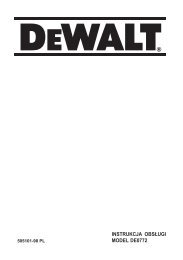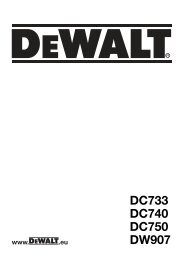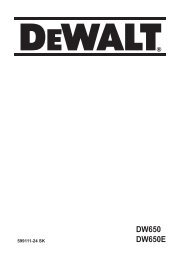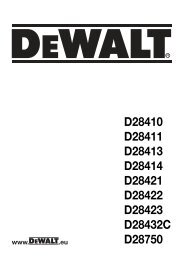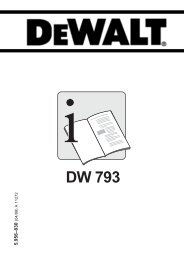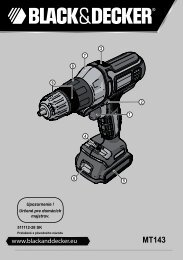rotationslaser dw075 - Service après vente - Dewalt
rotationslaser dw075 - Service après vente - Dewalt
rotationslaser dw075 - Service après vente - Dewalt
- No tags were found...
Create successful ePaper yourself
Turn your PDF publications into a flip-book with our unique Google optimized e-Paper software.
ENGLISHField Calibration Check (fig. 10–12)WARNING: Always have the laser headcalibrated by a qualified repair agent.Field calibration checks should be done frequently.NOTE: As part of the DEWALT guarantee,the owner is entitled to one FREE calibrationservice within the first year. Simply completethe enclosed voucher and return along with thelaser and proof of purchase to an authorisedDEWALT agent. A certificate will be awarded atno additional charge.Field calibration checks do not calibrate the laser.These checks indicate whether or not the laser isproviding a correct level and plumb line and do notcorrect errors in the leveling or plumbing capabilityof the laser.These checks cannot take the place of professionalcalibration performed by a DEWALT service centre.LEVEL CALIBRATION CHECK (X-AXIS)1. Set up a tripod between two walls that are atleast 50 feet (15 m) apart. The exact location ofthe tripod is not critical.2. Mount the laser unit on the tripod so that theX-axis points directly toward one of the walls.3. Turn the laser unit on and allow it to self-level.4. Mark and measure points A and B on the wallsas shown in Figure 10.5. Turn the entire laser unit 180º so the X-axispoints directly toward the opposite wall.6. Allow the laser unit to self-level, and mark andmeasure points AA and BB on the walls asshown in Figure 11.7. Calculate the total error using the equation:Total Error = (AA – A) – (BB – B)8. Compare total error to the allowable limitsshown in the following table.Distance between walls Allowable ErrorL = 15 m (50') 6 mm (0.25")L = 25 m (80') 10 mm (0.4")L = 50 m (160') 20 mm (0.8")LEVEL CALIBRATION CHECK (Y-AXIS)Repeat the procedure above, but with the laser unitpositioned so the Y-axis is pointed directly towardthe walls.PLUMB ERROR CHECK (FIG. 12)1. Using a standard plumb bob as a reference,mark the top and bottom of a wall. (Be sure tomark the wall and not the floor and ceiling.)2. Position the rotary laser securely on the floorapproximately 1 m (3') from the wall.3. Turn the laser on, and point the dot at themark on the bottom of the wall. Then, using theup/down arrows on the remote control, rotatethe dot upwards. If the center of the dot scansover the mark on the top of the wall, the laser isproperly calibrated.NOTE: This check should be done with a wall noshorter than the tallest wall for which this laser willbe used.CleaningWARNING:• Remove the batteries before cleaningyour laser unit.• Never use solvents or other harshchemicals for cleaning the nonmetallicparts of the laser. Use a clothdampened only with water and mildsoap.• Never let any liquid get inside theunit; never immerse any part of theunit into a liquid.• Never use compressed air to cleanthe laser.• Keep the ventilation slots clear andregularly clean the housing with asoft cloth.• The flexible rubber shield can becleaned with a wet lint-free clothsuch as a cotton cloth. USE WATERONLY — DO NOT use cleansersor solvents. Allow the unit to air drybefore storing.• Under some conditions, the glasslens inside the rotary head maycollect some dirt or debris. This willaffect beam quality and operatingrange. The lens should be cleanedwith a cotton swab moistened withwater.34



